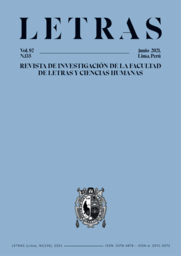Classical tradition in Mercurio Peruano (1791-1795): readings of an enlightened colonial society on the classics of Greece and Rome
Abstract
Through the identification and review of citations and allusions to works and authors of the Greco-Roman Classical Antiquity in the newspaper Mercurio Peruano (1791-1795), the article starts from an approach given by the history of reading and by Classical Reception Studies, to analyze the says of approaching and levels of reading that the literate society of Peru, at the end of the 18th century, could have developed to enter into contact and dialogue with classical culture. The study is contextualized through an analysis of the titles of classical works and about the ancient world that could circulate in the literate fields and through the educational system of the colonial world. With this, it shows that the authors and readers of the MercurioPeruano had a multiple, dynamic and complex knowledge of the classical authors and their works, which they approached through direct, indirect and measured readings. In this way, they appropriated them as voices of authority and as principles that produce meaning and identity for the formulation and legitimation of their own local and enlightened discourses, accounting for the validity of ancient classical culture, by then, in the enlightened circuit of the colonial society.Downloads
Métricas alternativas
References
Guibovich, P. (2005). Alcances y límites de un proyecto ilustrado: la Sociedad de Amantes del País y el Mercurio Peruano. Histórica, XXIV (2), 45-66. http://revistas.pucp.edu.pe/index.php/historica/article/view/1277
Guibovich, P. (2019). Libros y lectores. Circulación y consumo de la literatura del Renacimiento europeo en el virreinato peruano, siglos XVI y XVII. Telar, 22, 37-47.
Hampe, T. (1987). La difusión de libros e ideas en el Perú colonial. Análisis de bibliotecas particulares (siglo XVI). Bulletin Hispanique, 89, 55-84. https://doi.org/10.3406/hispa.1987.4613
Hampe, T. (1990). Libros profanos y sagrados en la Biblioteca del Tesorero Antonio Dávalos (Lima, 1583). Fenix, 36-37, 125-145. https://doi.org/10.51433/fenix-bnp.1990-1991.n36-37.p125-145
Hampe, T. (1996). Bibliotecas privadas en el mundo colonial. Madrid: Iberoamericana.
Hardwick, L. (2003). Reception studies. Greece & Rome, 33. Oxford: Oxford University Press.
Leonard, I. (1942). Best Sellers of the Lima Book Trade, 1583. The Hispanic American Historical Review, 22, 5-33. https://doi.org/10.2307/2507009
Martindale, C. (1993). Redeeming the Text: Latin Poetry and the Hermeneutics of Reception. Cambridge: Cambridge University Press.
Medina, J. (1966). La imprenta en Lima (1584-1824). Santiago: Fondo histórico y bibliográfico José Toribio Medina.
Mercurio Peruano. (1964). Mercurio Peruano. Edición facsimilar. Lima: Biblioteca Nacional del Perú.
Ojeda, R. (2015). El Mercurio Peruano del siglo XVIII: la Sociedad de Amantes del País y la prensa de Ilustración. Comunifé. Revista de Comunicación Social, XV (15), 59-73. https://doi.org/10.33539/comunife.2015.n15.1837
Orellana, E. (1759). Instrucción de la lengua latina o Arte de adquirirla por la traducción de los autores, compuesta para la particular enseñanza de unos niños. Lima: Oficina de los Niños Huérfanos.
Orellana, E. (1760). Lugares selectos de autores latinos de prosa más excelentes para exercicio de la traducción. Lima: Imprenta de los Huerphanos.
Osorio, I. (1980). Floresta de gramática, poética y retórica en Nueva España (1521-1767). Ciudad de México: Universidad Nacional Autónoma de México.
Poupeney, C. (2009). Hacia una cartografía de la ilustración americana: los pliegues de la escritura en el Mercurio Peruano. Revista de crítica literaria latinoamericana, XXXV (70), 165-182.
Ratio Studiorum. (1635). Ratio atque Institutio Studiorum Societatis Jesu. Auctoritate Septimae Congregationis Generalis aucta. Antverpiae apud Joan Meursium. Salamanca: Universidad de Salamanca, Fondo Antiguo, 10366-46051.
Rivara de Tuesta, M. (1999). La influencia de los clásicos en la filosofía colonial peruana.
Fray Jerónimo de Valera (1568-1625). En T. Hampe (Ed.), La tradición clásica en el Perú virreinal (pp. 47-65). Lima: Universidad Nacional Mayor de San Marcos.
Solís, M. (2005). La obra de José Rossi y Rubí en el Mercurio Peruano: búsqueda y creación del lector criollo ilustrado. (Tesis de Magíster). Universidad de Montreal, Montreal, Canadá.
Taboada, H. (2014). Centauros y eruditos: los clásicos en la Independencia. Latinoamérica. Revista de estudios latinoamericanos, 59, 193-221. https://doi.org/10.1016/S1665-8574(14)71730-2
The Monthly Review. (1806). The Monthly Review, volumen L. Londres: T. Becket.
Vásquez, C. (1999). La Ratio: sus inicios, desarrollo y proyección. Revista Portuguesa de Filosofía, 55 (3), 229-252. https://www.jstor.org/stable/40337390
Villalobos, A. (2012). La enseñanza de la historia universal antigua: participación y tipología de los Manuales de Historia en Chile republicano, 1810-1876. Revista de Historia Americana y Argentina, 52 (2), 11-40.
Willen, G. (1956). Algunas bibliotecas privadas de Lima a través de los inventarios de bienes (1800-1821). Lima: Universidad Nacional Mayor de San Marcos.
Windler, C. (1997). Élites locales, señores, reformistas. Redes clientelares y monarquía hacia finales del Antiguo Régimen. Sevilla: Universidad de Sevilla.
Zeta, R. (2000). El pensamiento ilustrado en el Mercurio Peruano (1791-1794). Piura: Universidad de Piura.
Copyright (c) 2021 Letras (Lima)

This work is licensed under a Creative Commons Attribution 4.0 International License.
Este obra está bajo una licencia de Creative Commons Reconocimiento 4.0 Internacional



















